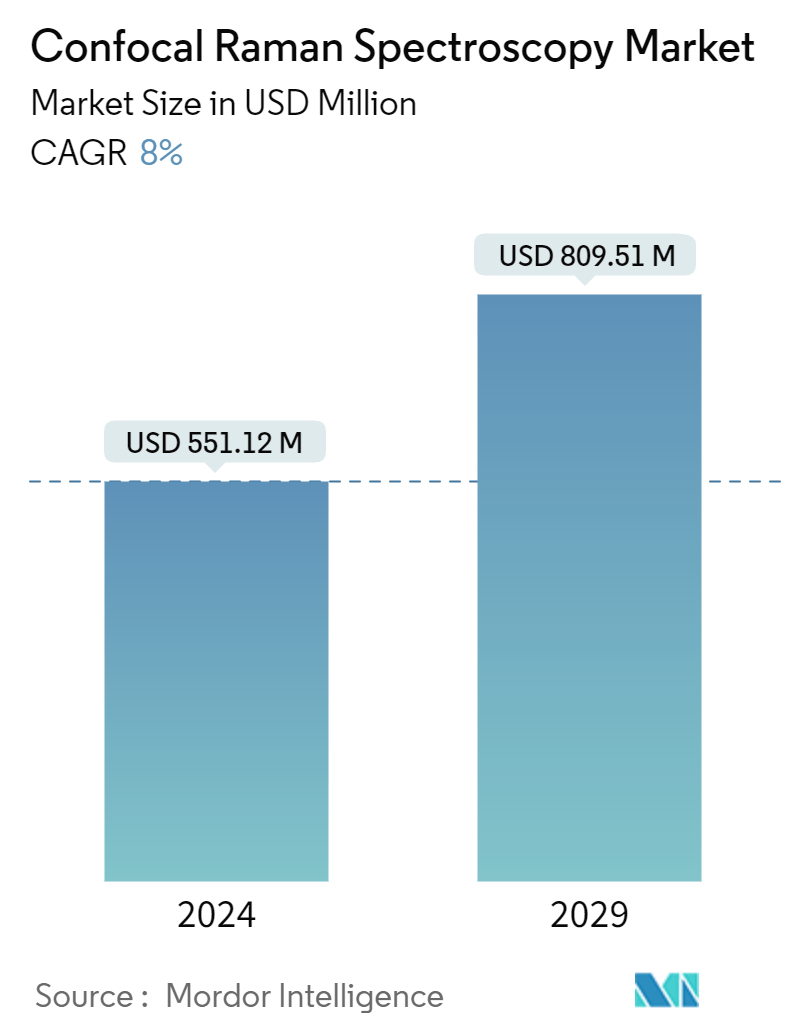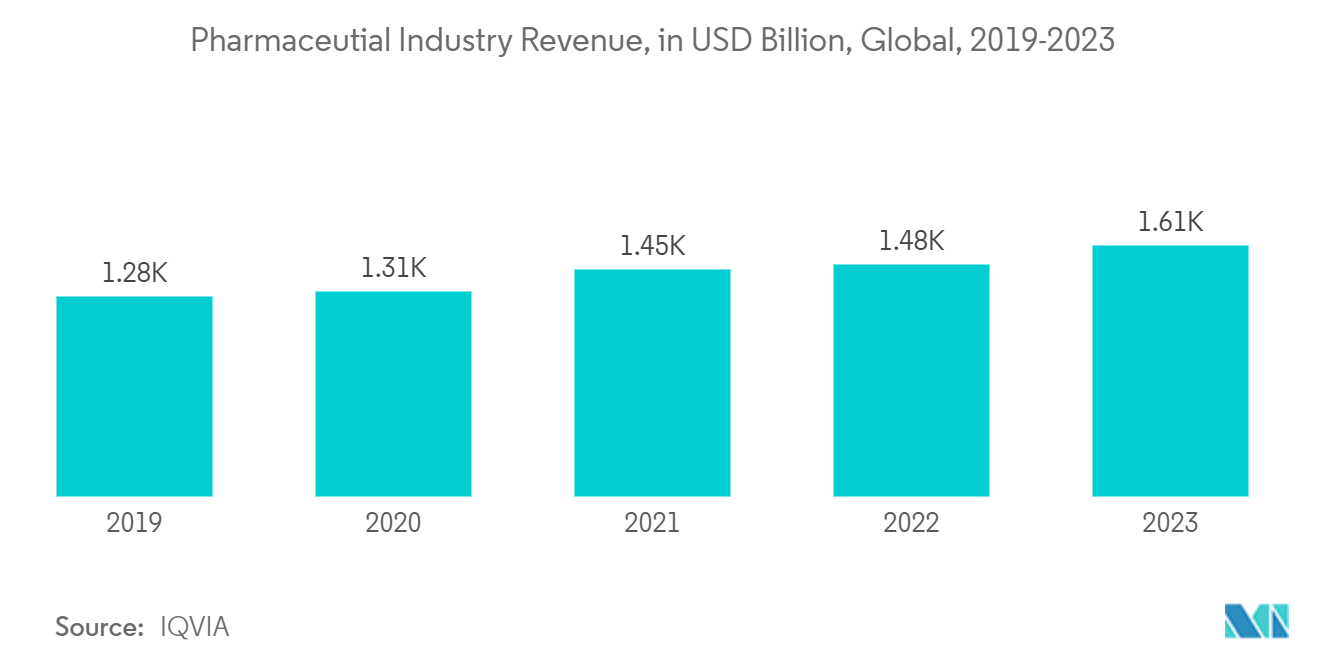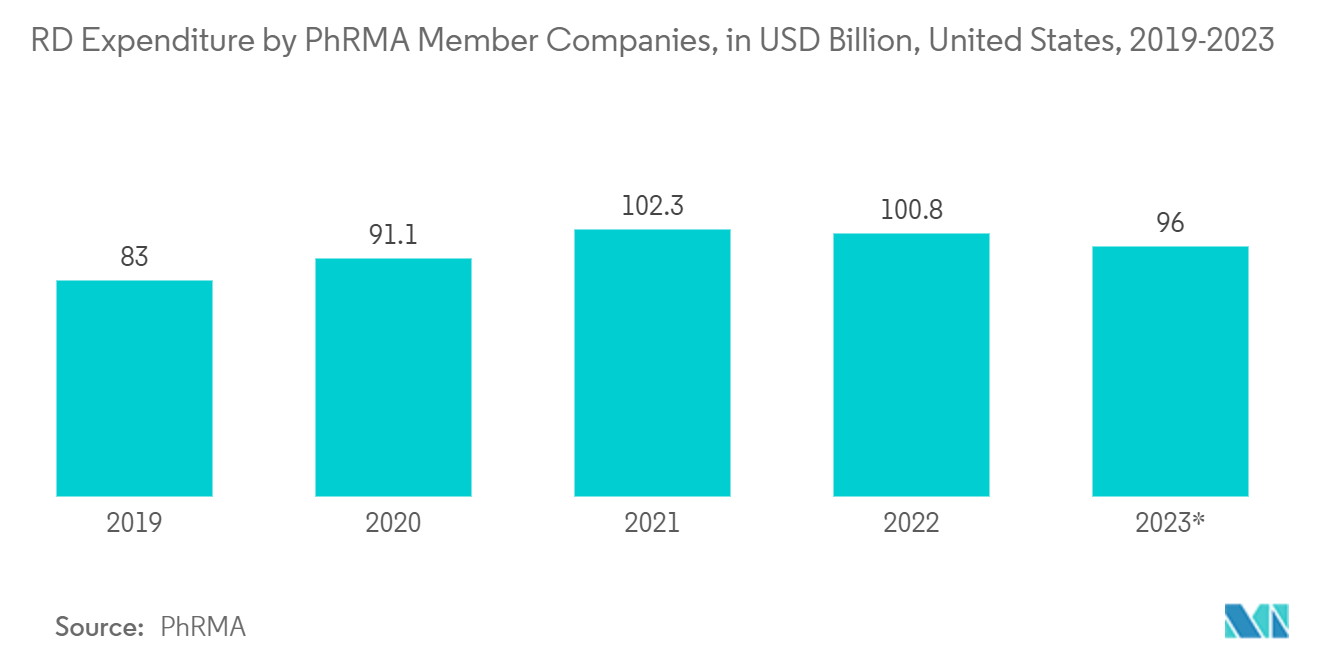Confocal Raman Spectroscopy Market Size

| Study Period | 2019 - 2029 |
| Market Size (2024) | USD 551.12 Million |
| Market Size (2029) | USD 809.51 Million |
| CAGR (2024 - 2029) | 8.00 % |
| Fastest Growing Market | Asia Pacific |
| Largest Market | North America |
Major Players
*Disclaimer: Major Players sorted in no particular order |
Confocal Raman Spectroscopy Market Analysis
The Confocal Raman Spectroscopy Market size is estimated at USD 551.12 million in 2024, and is expected to reach USD 809.51 million by 2029, growing at a CAGR of 8% during the forecast period (2024-2029).
- Confocal Raman spectroscopy has transitioned from a specialized analytical technique to an essential tool across diverse research and industrial sectors, primarily due to its distinct advantages over other spectroscopic and visible microscopy methods. This evolution underscores its growing importance and widespread adoption in various fields.
- Raman spectroscopy excels in chemical and molecular analyses, pinpointing unknown compounds in areas smaller than a micron. When paired with a moving stage, it adeptly maps sample areas, making it invaluable for samples with distinct patterns or regions. Furthermore, its depth profiling capability reveals sample layers without any prior preparation. Raman spectroscopy has applications in several fields, from identifying and mapping multilayer samples and minerals to discerning particulates and analyzing chemical distribution. These capabilities make it a versatile and powerful tool in scientific research and industrial applications.
- In drug discovery and development, Raman spectroscopy plays a pivotal role, aiding in substance identification, atomic science examination, diagnostics, preformulation, structure screening, bioanalysis, late-stage drug development investigations, quality control, and counterfeit detection. Preformulation studies, crucial in drug development, leverage Raman spectroscopy to gain insights into the physicochemical properties of potential medications, facilitating preclinical and clinical trials. This comprehensive approach ensures that new drugs are thoroughly evaluated and optimized before reaching the market.
- Factors that drive the growth of the confocal Raman spectroscopy market include advancements in photonics and material science, a surge in life sciences applications, and the pharmaceutical industry's increasing reliance on non-destructive analytical methods. The introduction of Raman spectroscopy has transformed the landscape, offering unprecedented flexibility and accessibility. These technological advancements have expanded the scope and efficiency of Raman spectroscopy, making it an indispensable tool in modern research and industry.
- However, the market faces challenges, notably the high costs and complexities tied to the instrumentation. These factors can hinder widespread adoption and limit the accessibility of this advanced technology to smaller research institutions and companies. Addressing these restraints is essential for the swift growth and development of the confocal Raman spectroscopy market.
Confocal Raman Spectroscopy Market Trends
The Portable Segment is Driving Popularity
- Driven by various factors, the market for portable high-quality Raman spectrometers is witnessing notable growth. A primary catalyst is the rising demand for portable analytical tools in industries like pharmaceuticals, biotechnology, and environmental monitoring.
- For instance, according to Maersk, the Indian pharmaceutical industry, frequently referred to as the 'pharmacy of the world,' is experiencing significant growth. The industry's value surged from USD 40 billion in 2021 and is projected to reach USD 130 billion by 2030, with ambitious forecasts suggesting a leap to USD 450 billion by 2047. This uptick, fueled by escalating life sciences R&D, underscores the heightened need for on-site analyses, swift substance identification, and non-destructive testing.
- Over the past two decades, portable Raman spectrometers have shrunk in size while their performance has seen a marked enhancement. This evolution is attributed to the closer integration of components, a shift from reflection to transmission gratings, and notable strides in electronics, display, and battery technologies. These advancements have collectively contributed to making portable Raman spectrometers more efficient, reliable, and user-friendly, thereby increasing their adoption across various industries.
- The rationale behind portable spectroscopic instruments is about taking the spectrometer to the sample rather than the other way around. This shift effectively relocates the laboratory to the sample's location. Such portability empowers users to make timely, informed decisions, delivering actionable results precisely when and where needed.
- These advantages are significantly bolstering the demand for portable confocal Raman spectroscopy. The ability to conduct on-site analysis without the need for extensive sample preparation or transportation to a central laboratory saves time and resources, further driving the market's growth.
- Additionally, the versatility of portable Raman spectrometers in handling a wide range of applications, from quality control in manufacturing to field research in environmental science, makes them indispensable tools in modern analytical practices.

North America Expected to Dominate the Market
- Biomedical advances are reshaping the healthcare sector on a global scale. The sector, comprising multiple stakeholders, has weathered the storms of the global COVID-19 pandemic. Post-pandemic, it has been recalibrating its focus on future opportunities. The aim is to deepen the understanding of human biology and diseases, innovate and develop new therapeutics, and substantiate the clinical value of these advancements, benefiting individual patients, broader populations, and entire health systems.
- In North America, particularly in the United States, the pharmaceutical industry annually rolls out a diverse array of new drugs, each offering significant medical benefits. The Pharmaceutical Research and Manufacturers of America (PhRMA), a prominent trade group, champions the interests of leading biopharmaceutical research firms across the United States. In 2023, member companies of PhRMA collectively invested approximately USD 96 billion in research and development (R&D) on a global scale.
- Over the past decade, there has been a notable uptick in the annual approval of new drugs. Data from Nature Reviews highlighted that in 2023, the FDA greenlit 55 novel therapeutics, marking it as the second-highest approval tally in the previous three decades.
- Moreover, governmental initiatives are actively bolstering biotechnology's role in the region. A prime example is President Biden's Executive Order (EO) titled “Advancing Biotechnology and Biomanufacturing Innovation for a Sustainable, Safe, and Secure American Bioeconomy.”
- The EO advocates for a unified governmental strategy to propel biotechnology and biomanufacturing. This includes crafting a research agenda pinpointing foundational and application-driven R&D needs, aiming for breakthroughs in health, energy, climate change, food security, agriculture, supply chain resilience, and both national and economic security.
- Given these dynamics, the market is poised for growth. Confocal Raman spectroscopy, renowned for its micron-level resolution and pristine image quality, is a go-to tool for studying microorganisms. Its non-destructive, water-free capabilities make it exceptionally adept at detecting single microbial cells in situ.

Confocal Raman Spectroscopy Industry Overview
- The confocal Raman Spectroscopy market is characterized by a concentration of both global and regional players. Key players, such as Horiba Ltd, Renishaw PLC, Agilent Technologies, Rikagu Corporation, Bruker Corporation, and Oxford Instruments, are actively pursuing partnerships, mergers, acquisitions, and investments to strengthen their foothold in the market. These strategic endeavors are paving the way for expanded market growth and increased competitiveness.
- The market is undergoing a major transformation, driven by a surge of innovations aimed at boosting performance and enhancing user experience. In recent years, cutting-edge Raman spectrometers have been introduced, prioritizing convenience without sacrificing accuracy. A notable advancement is the integration of cloud computing and AI for data analysis, ushering in a new level of sophistication in result interpretation. These technological developments are not only enhancing the efficiency of the spectrometers but also making them more approachable to a wider range of users.
- There is a pronounced demand for methods to characterize carbon nanomaterials, spurred by heightened interest in their processing, modification, and customization. As a result, confocal Raman spectroscopy has emerged as the premier technique for examining these materials, leading to burgeoning opportunities in the market. The ability of confocal Raman spectroscopy to provide detailed insights into the structural and chemical properties of carbon nanomaterials makes it an invaluable tool in various research and industrial applications, further driving its adoption and market growth.
Confocal Raman Spectroscopy Market Leaders
-
HORIBA Ltd.
-
Rikagu Corporation
-
Agilent Technologies Inc.
-
Oxford Instruments
-
PerkinElmer Inc.
*Disclaimer: Major Players sorted in no particular order

Confocal Raman Spectroscopy Market News
- June 2024: The Shimadzu AIRsight Infrared/Raman Microscope revolutionized molecular analysis. By merging Fourier transform infrared (FTIR) and Raman spectroscopy into a single instrument, it equips researchers with a robust tool for in-depth sample examination. This innovation allows for the simultaneous acquisition of both spectra from a stationary sample, streamlining the process and enhancing the accuracy of technique correlation.
- February 2024: Brukar Corporation acquired Nanophoton Corporation, which is based in Osaka and boasts a diverse range of cutting-edge Raman microscopes, catering to both academic and industrial research, predominantly in Japan. This strategic move enhanced Bruker's molecular microscopy offerings. The company aims to promote Nanophoton's rapid, adaptable, and sensitive Raman systems globally across various fields, including life sciences, biopharma, advanced materials, semiconductors, and polymers.
Confocal Raman Spectroscopy Market Report - Table of Contents
1. INTRODUCTION
- 1.1 Study Assumptions and Market Definition
- 1.2 Scope of the Study
2. RESEARCH METHODOLOGY
3. EXECUTIVE SUMMARY
4. MARKET INSIGHTS
- 4.1 Market Overview
-
4.2 Industry Attractiveness - Porter's Five Forces Analysis
- 4.2.1 Threat of New Entrants
- 4.2.2 Bargaining Power of Buyers
- 4.2.3 Bargaining Power of Suppliers
- 4.2.4 Threat of Substitute Products
- 4.2.5 Intensity of Competitive Rivalry
- 4.3 Industry Value Chain Analysis
- 4.4 Impact of Macroeconomic Factors on the Market
5. MARKET DYNAMICS
-
5.1 Market Drivers
- 5.1.1 Rising Investment Towards Drug Development
- 5.1.2 Growing Application in Forensic Science, Food Safety, and Gemology
-
5.2 Market Restraints
- 5.2.1 High Cost and Complexities Associated
6. MARKET SEGMENTATION
-
6.1 By Type
- 6.1.1 Desktop
- 6.1.2 Portable
-
6.2 By End User
- 6.2.1 Pharmaceuticals
- 6.2.2 R&D in Academia
- 6.2.3 Industrial Sectors
- 6.2.4 Others
-
6.3 By Geography
- 6.3.1 North America
- 6.3.2 Europe
- 6.3.3 Asia
- 6.3.4 Australia and New Zealand
- 6.3.5 Latin America
- 6.3.6 Middle East and Africa
7. COMPETITIVE LANDSCAPE
-
7.1 Company Profiles
- 7.1.1 HORIBA Ltd
- 7.1.2 Rikagu Corporation
- 7.1.3 Agilent Technologies
- 7.1.4 Oxford Instruments
- 7.1.5 PerkinElmer Inc.
- 7.1.6 Renishaw PLC
- 7.1.7 Bruker Corporation
- 7.1.8 Thermo Fisher Scientific Inc.
- 7.1.9 Mettler Toledo
- 7.1.10 Hamamatsu Photonics KK
- *List Not Exhaustive
8. INVESTMENT ANALYSIS
9. FUTURE OF THE MARKET
** Subject To AvailablityConfocal Raman Spectroscopy Industry Segmentation
Confocal Raman Spectroscopy merges the strengths of confocal imaging and Raman spectroscopy, offering unique advantages that neither FTIR spectroscopy nor scanning electron microscopy (SEM) can match. Furthermore, CRM's high resolution effectively fills the dimensional measurement gap between these two techniques.
The confocal Raman spectroscopy market is segmented by type (desktop and portable), end user (pharmaceutics, R&D in academia, industrial sectors, and others), and geography (North America, Europe, Asia-Pacific, Latin America, and Middle East and Africa). The market sizes and forecasts are provided in terms of value (USD) for all the above segments.
| By Type | Desktop |
| Portable | |
| By End User | Pharmaceuticals |
| R&D in Academia | |
| Industrial Sectors | |
| Others | |
| By Geography | North America |
| Europe | |
| Asia | |
| Australia and New Zealand | |
| Latin America | |
| Middle East and Africa |
Confocal Raman Spectroscopy Market Research FAQs
How big is the Confocal Raman Spectroscopy Market?
The Confocal Raman Spectroscopy Market size is expected to reach USD 551.12 million in 2024 and grow at a CAGR of 8% to reach USD 809.51 million by 2029.
What is the current Confocal Raman Spectroscopy Market size?
In 2024, the Confocal Raman Spectroscopy Market size is expected to reach USD 551.12 million.
Who are the key players in Confocal Raman Spectroscopy Market?
HORIBA Ltd., Rikagu Corporation, Agilent Technologies Inc., Oxford Instruments and PerkinElmer Inc. are the major companies operating in the Confocal Raman Spectroscopy Market.
Which is the fastest growing region in Confocal Raman Spectroscopy Market?
Asia Pacific is estimated to grow at the highest CAGR over the forecast period (2024-2029).
Which region has the biggest share in Confocal Raman Spectroscopy Market?
In 2024, the North America accounts for the largest market share in Confocal Raman Spectroscopy Market.
What years does this Confocal Raman Spectroscopy Market cover, and what was the market size in 2023?
In 2023, the Confocal Raman Spectroscopy Market size was estimated at USD 507.03 million. The report covers the Confocal Raman Spectroscopy Market historical market size for years: 2019, 2020, 2021, 2022 and 2023. The report also forecasts the Confocal Raman Spectroscopy Market size for years: 2024, 2025, 2026, 2027, 2028 and 2029.
Confocal Raman Spectroscopy Industry Report
Statistics for the 2024 Confocal Raman Spectroscopy market share, size and revenue growth rate, created by Mordor Intelligence™ Industry Reports. Confocal Raman Spectroscopy analysis includes a market forecast outlook for 2024 to 2029 and historical overview. Get a sample of this industry analysis as a free report PDF download.



